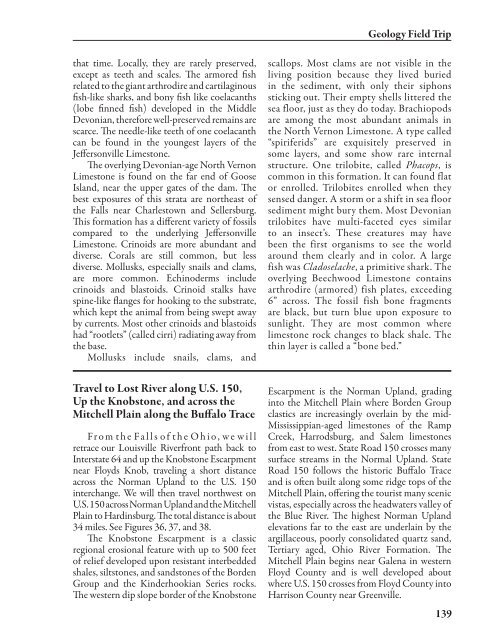Lost River - Karst Information Portal
Lost River - Karst Information Portal
Lost River - Karst Information Portal
Create successful ePaper yourself
Turn your PDF publications into a flip-book with our unique Google optimized e-Paper software.
that time. Locally, they are rarely preserved,<br />
except as teeth and scales. The armored fish<br />
related to the giant arthrodire and cartilaginous<br />
fish-like sharks, and bony fish like coelacanths<br />
(lobe finned fish) developed in the Middle<br />
Devonian, therefore well-preserved remains are<br />
scarce. The needle-like teeth of one coelacanth<br />
can be found in the youngest layers of the<br />
Jeffersonville Limestone.<br />
The overlying Devonian-age North Vernon<br />
Limestone is found on the far end of Goose<br />
Island, near the upper gates of the dam. The<br />
best exposures of this strata are northeast of<br />
the Falls near Charlestown and Sellersburg.<br />
This formation has a different variety of fossils<br />
compared to the underlying Jeffersonville<br />
Limestone. Crinoids are more abundant and<br />
diverse. Corals are still common, but less<br />
diverse. Mollusks, especially snails and clams,<br />
are more common. Echinoderms include<br />
crinoids and blastoids. Crinoid stalks have<br />
spine-like flanges for hooking to the substrate,<br />
which kept the animal from being swept away<br />
by currents. Most other crinoids and blastoids<br />
had “rootlets” (called cirri) radiating away from<br />
the base.<br />
Mollusks include snails, clams, and<br />
Travel to <strong>Lost</strong> <strong>River</strong> along U.S. 150,<br />
Up the Knobstone, and across the<br />
Mitchell Plain along the Buffalo Trace<br />
Fr o m t h e Fa l l s o f t h e O h i o , w e w i l l<br />
retrace our Louisville <strong>River</strong>front path back to<br />
Interstate 64 and up the Knobstone Escarpment<br />
near Floyds Knob, traveling a short distance<br />
across the Norman Upland to the U.S. 150<br />
interchange. We will then travel northwest on<br />
U.S. 150 across Norman Upland and the Mitchell<br />
Plain to Hardinsburg. The total distance is about<br />
34 miles. See Figures 36, 37, and 38.<br />
The Knobstone Escarpment is a classic<br />
regional erosional feature with up to 500 feet<br />
of relief developed upon resistant interbedded<br />
shales, siltstones, and sandstones of the Borden<br />
Group and the Kinderhookian Series rocks.<br />
The western dip slope border of the Knobstone<br />
Geology Field Trip<br />
scallops. Most clams are not visible in the<br />
living position because they lived buried<br />
in the sediment, with only their siphons<br />
sticking out. Their empty shells littered the<br />
sea floor, just as they do today. Brachiopods<br />
are among the most abundant animals in<br />
the North Vernon Limestone. A type called<br />
“spiriferids” are exquisitely preserved in<br />
some layers, and some show rare internal<br />
structure. One trilobite, called Phacops, is<br />
common in this formation. It can found flat<br />
or enrolled. Trilobites enrolled when they<br />
sensed danger. A storm or a shift in sea floor<br />
sediment might bury them. Most Devonian<br />
trilobites have multi-faceted eyes similar<br />
to an insect’s. These creatures may have<br />
been the first organisms to see the world<br />
around them clearly and in color. A large<br />
fish was Cladoselache, a primitive shark. The<br />
overlying Beechwood Limestone contains<br />
arthrodire (armored) fish plates, exceeding<br />
6” across. The fossil fish bone fragments<br />
are black, but turn blue upon exposure to<br />
sunlight. They are most common where<br />
limestone rock changes to black shale. The<br />
thin layer is called a “bone bed.”<br />
Escarpment is the Norman Upland, grading<br />
into the Mitchell Plain where Borden Group<br />
clastics are increasingly overlain by the mid-<br />
Mississippian-aged limestones of the Ramp<br />
Creek, Harrodsburg, and Salem limestones<br />
from east to west. State Road 150 crosses many<br />
surface streams in the Normal Upland. State<br />
Road 150 follows the historic Buffalo Trace<br />
and is often built along some ridge tops of the<br />
Mitchell Plain, offering the tourist many scenic<br />
vistas, especially across the headwaters valley of<br />
the Blue <strong>River</strong>. The highest Norman Upland<br />
elevations far to the east are underlain by the<br />
argillaceous, poorly consolidated quartz sand,<br />
Tertiary aged, Ohio <strong>River</strong> Formation. The<br />
Mitchell Plain begins near Galena in western<br />
Floyd County and is well developed about<br />
where U.S. 150 crosses from Floyd County into<br />
Harrison County near Greenville.<br />
139















